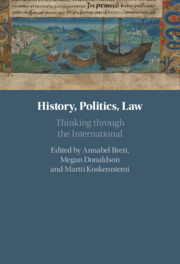22 results
Peace, war, law: teaching international law in contexts
-
- Journal:
- International Journal of Law in Context / Volume 18 / Issue 4 / December 2022
- Published online by Cambridge University Press:
- 22 November 2022, pp. 393-402
-
- Article
-
- You have access
- Open access
- HTML
- Export citation
3 - Accountability
-
-
- Book:
- The Cambridge Companion to International Organizations Law
- Published online:
- 31 March 2022
- Print publication:
- 07 April 2022, pp 50-75
-
- Chapter
- Export citation
Part II - Thinking through the International
-
- Book:
- History, Politics, Law
- Published online:
- 28 September 2021
- Print publication:
- 07 October 2021, pp 127-380
-
- Chapter
- Export citation
Law and Constructions of the Political
- from Part II - Thinking through the International
-
- Book:
- History, Politics, Law
- Published online:
- 28 September 2021
- Print publication:
- 07 October 2021, pp 129-188
-
- Chapter
- Export citation
Institutions and Persons
- from Part II - Thinking through the International
-
- Book:
- History, Politics, Law
- Published online:
- 28 September 2021
- Print publication:
- 07 October 2021, pp 229-282
-
- Chapter
- Export citation
Notes on Contributors
-
- Book:
- History, Politics, Law
- Published online:
- 28 September 2021
- Print publication:
- 07 October 2021, pp ix-xii
-
- Chapter
- Export citation
Gender
- from Part II - Thinking through the International
-
- Book:
- History, Politics, Law
- Published online:
- 28 September 2021
- Print publication:
- 07 October 2021, pp 339-340
-
- Chapter
- Export citation
Part I - Methods, Approaches and Encounters
-
- Book:
- History, Politics, Law
- Published online:
- 28 September 2021
- Print publication:
- 07 October 2021, pp 17-126
-
- Chapter
- Export citation
Empires, States and Nations
- from Part II - Thinking through the International
-
- Book:
- History, Politics, Law
- Published online:
- 28 September 2021
- Print publication:
- 07 October 2021, pp 189-228
-
- Chapter
- Export citation
Index
-
- Book:
- History, Politics, Law
- Published online:
- 28 September 2021
- Print publication:
- 07 October 2021, pp 381-410
-
- Chapter
- Export citation
Introduction - History, Politics, Law
-
-
- Book:
- History, Politics, Law
- Published online:
- 28 September 2021
- Print publication:
- 07 October 2021, pp 1-16
-
- Chapter
- Export citation
Copyright page
-
- Book:
- History, Politics, Law
- Published online:
- 28 September 2021
- Print publication:
- 07 October 2021, pp iv-iv
-
- Chapter
- Export citation
Acknowledgments
-
- Book:
- History, Politics, Law
- Published online:
- 28 September 2021
- Print publication:
- 07 October 2021, pp vii-viii
-
- Chapter
- Export citation
10 - Ventriloquism in Geneva: The League of Nations as International Organisation
- from Institutions and Persons
-
-
- Book:
- History, Politics, Law
- Published online:
- 28 September 2021
- Print publication:
- 07 October 2021, pp 253-282
-
- Chapter
- Export citation
Contents
-
- Book:
- History, Politics, Law
- Published online:
- 28 September 2021
- Print publication:
- 07 October 2021, pp v-vi
-
- Chapter
- Export citation
Economics and Innovation
- from Part II - Thinking through the International
-
- Book:
- History, Politics, Law
- Published online:
- 28 September 2021
- Print publication:
- 07 October 2021, pp 283-338
-
- Chapter
- Export citation

History, Politics, Law
- Thinking through the International
-
- Published online:
- 28 September 2021
- Print publication:
- 07 October 2021
5 - The Boundaries of Peace-Making
- from Part I - Historical Dimensions to Peace Settlement Practice
-
-
- Book:
- International Law and Peace Settlements
- Published online:
- 14 January 2021
- Print publication:
- 04 February 2021, pp 86-108
-
- Chapter
- Export citation
The Survival of the Secret Treaty: Publicity, Secrecy, and Legality in the International Order
-
- Journal:
- American Journal of International Law / Volume 111 / Issue 3 / July 2017
- Published online by Cambridge University Press:
- 29 November 2017, pp. 575-627
- Print publication:
- July 2017
-
- Article
- Export citation
Textual Settlements: The Sykes–Picot Agreement and Secret Treaty-Making
- Part of
-
- Journal:
- AJIL Unbound / Volume 110 / 2016
- Published online by Cambridge University Press:
- 20 January 2017, pp. 127-131
-
- Article
-
- You have access
- Export citation



